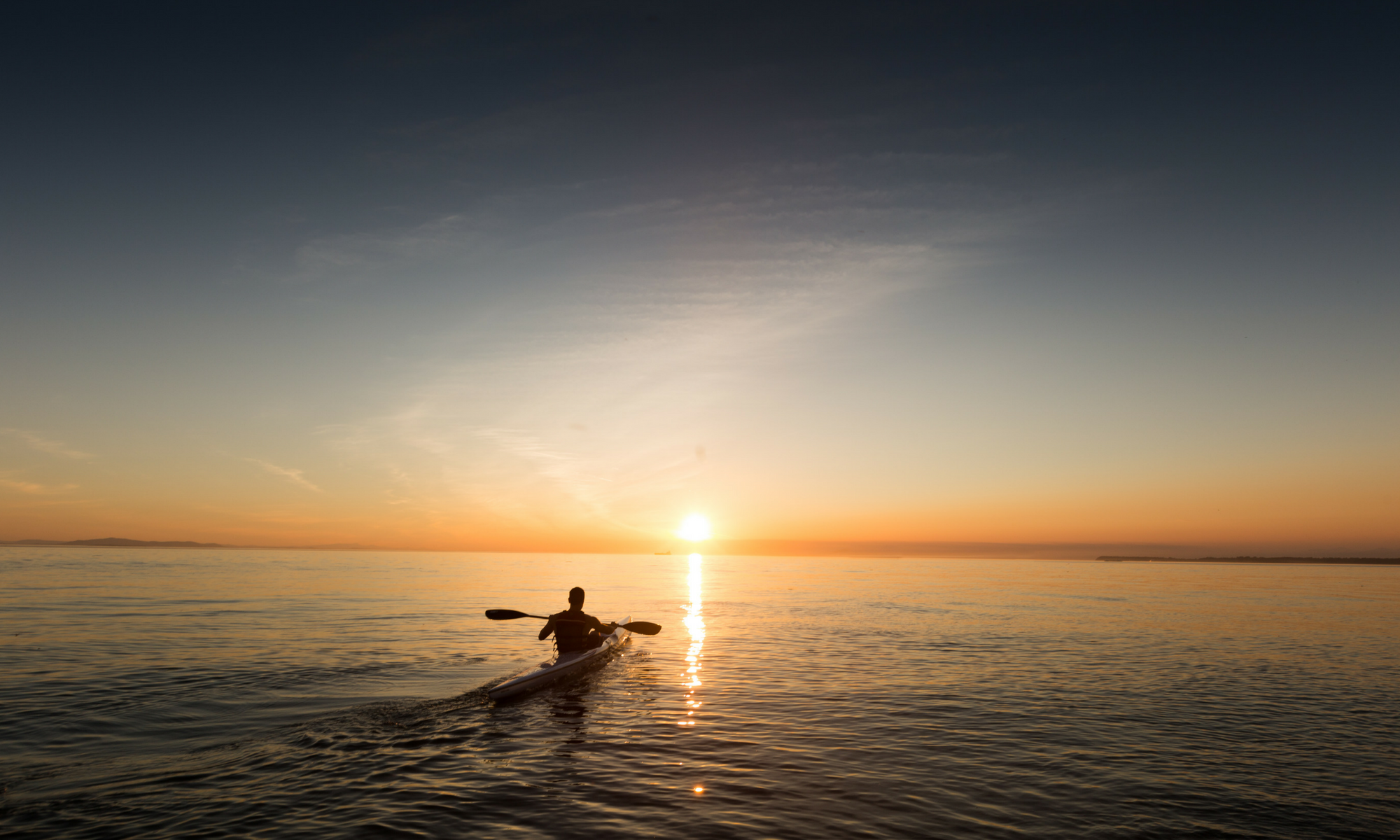Jump Ahead To:
The 5 Best Kayak Anchors [Guide for 2020]
When I say “anchor” you might immediately think of an extremely heavy, very large, irregularly shaped piece of metal that is used to fix a very large vessel (like the Titanic) to the ocean floor. You would be correct! But did you know that anchor also come in very small and portable sizes that are perfectly suited for kayak fishing? Well, they do!
This KayakFishingCorner.com post contains all of the important details about the 5 Best Kayak Anchors along with in depth explanations about how to use them and why they are an essential item in any serious kayak fishermen’s collection of gear! Let’s get started!
Please note: This post contains affiliate links. An affiliate link means that we may earn advertising/referral fees if you make a purchase through our links.
Top 3 Kayak Anchors – 2020 Guide
| Best Marine | Gradient Fitness | Grapnel System | |
| Product | 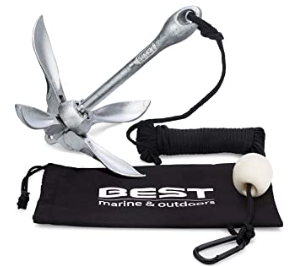 | 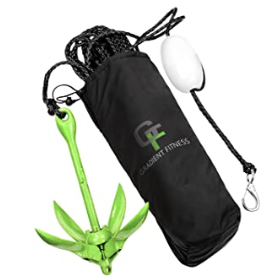 | 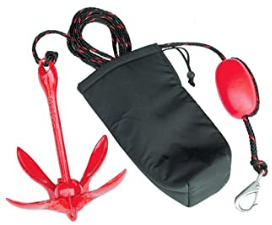 |
| Materials | Galvanized Iron | Aluminum | Cold Galvanized Carbon Steel; Paint Coating |
| Rope | Marine Grade; 40 Feet | Marine Grade; 25 feet (7mm thick) | Marine Grade; 25 feet or 50 feet |
| Weight | 3.5lbs (1.6kg) | 3.5lbs (1.6kg) | 3.33lbs (1.5kg); 5.5lbs (2.49kg) |
| Style | Fluke | Fluke | Fluke |
| Extra | Buoy Ball; Stainless Steel Carabiner Clip | PVC Flotation Buoy; Stainless Steel Snap Hook | Padded Nylon Storage Case. |
| (Commissions Earned) | Buy on Amazon | Buy on Amazon | Buy on Amazon |
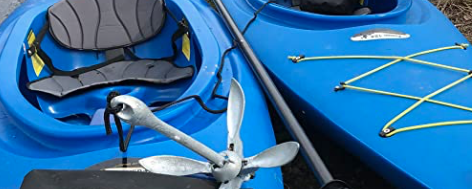
The 5 Best Kayak Anchors: Shortcut to 2020 Guide!
1. Best Marine
2. Gradient Fitness
3. Grapnel System
4. Extreme Max
5. Brush Gripper
Let’s move into a little item by item comparison. The detailed product reviews below will help you compare and contrast amongst the different kayak anchors. After all, every kayak fishermen is a little different from the next and one particular anchor may be a perfect fit for one particular fishermen, while another could be better suited for the other!
Parts of a Kayak Anchor
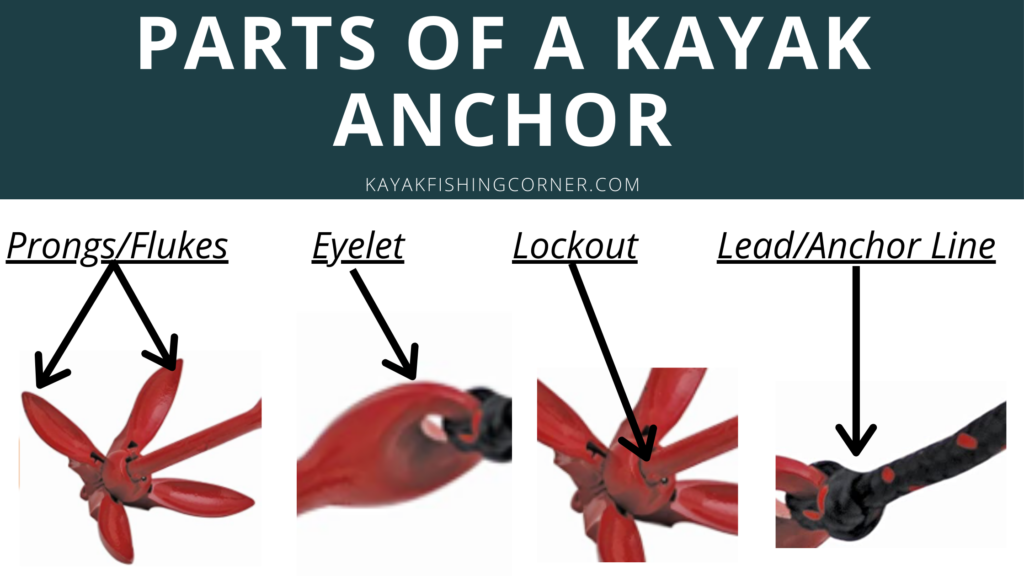
5 Best Kayak Anchors – In Depth Reviews
Please Note: As an Amazon Associate, I earn from qualifying purchases.
Best Marine

This is one of our favorite kayak anchors for a number of reasons. It is clear that the manufacturers designed the anchor with small watercraft in mind. That is why this anchor is so popular with kayak fishermen, single hull sail boats, and SUP (stand up paddle board) riders.
| Sneak Peak at the Best Marine Kayak Anchor |
| 1. Galvanized Iron Construction |
| 2. Marine Grade; 40 Feet Rope |
| 3. 3.5lbs (1.6kg) Weight |
| 4. Fluke Design |
| 5. Buoy Ball; Stainless Steel Carabiner Clip |
Galvanized Iron. This kayak anchor is made of a rust resistant galvanized iron. This means that the anchor has undergone an application of protective zinc in a light coating. The zinc will help to prevent rusting, which is an important feature for all kayak fishermen (and especially those who commonly fish in the ocean – and for those of you who do, you should look into getting an ocean kayak stabilizer).
Marine Grade; Rope. Typically, to be considered “marine grade“, a particular material has to be able to resist corrosion (i.e.: Rust) when exposed to an aquatic environment (like lakes, rivers and the ocean). Obviously this is an important feature to find, and is worth the extra money, as it will prolong the durability of your kayak anchor.
The rope measures 40 feet in length. This is appropriate in size, as most kayak fishermen will only anchor in relatively shallow waters (e.g.: 20 feet or less). With 40 feet to work with, you can safely anchor to ground and give your kayak plenty of lateral distance to float as the current dictates.
Weight. Weighing only 3.5 pounds, your back and arms will thank you as the anchor is very manageable to work with. Remember, you need to limit the amount of weight that you bring aboard. You also need to be sure that you can retrieve your anchor (haul it up) when you are ready to move to the next location. While it doesn’t seem like much weight, and its not, this engineering of this anchor (fluke design) doesn’t work on weight, so you need not be concerned with the anchor’s ability to keep you safely tethered.
Flukes. The flukes on this anchor are foldable, which is a very important feature to find in a kayak anchor. When preparing to throw or stow the anchor, fold the flukes (sometimes called “prongs”) in towards the center of the anchor. The prongs will automatically deploy when the anchor hits the water or, when stowing, will stay safely nestled toward the center of the anchor and take up far less space in your hull. The flukes are one of the reasons it has been named one of the 5 best kayak anchors!
Extra. The buoy ball is a nice ergonomic touch, as it floats freely along the rope to situate itself on top of the water. This will help you and others see where the entry point of your anchor is into the water. We also like the stainless steel connection clip (again, to avoid rust), which allows for quick connection and disconnection!
Gradient Fitness

Another fantastic choice of kayak anchor for serious kayak fishermen. This model afford tremendous “sticking” power while not adding needless weight. The carrying case is a nice bonus as well!
| Sneak Peak at the Gradient Fitness Kayak Anchor |
| 1. Aluminum |
| 2. Marine Grade; 25 feet |
| 3. 3.5lbs (1.6kg) |
| 4. Fluke |
| 5. PVC Flotation Buoy; Stainless Steel Snap Hook |
Aluminum. Built of high strength yet light weight aluminum, this kayak anchor affords you with maximum durability without extra bulk. It is important to be able to lift the anchor in and out of the kayak with ease, all without compromising the ability of the kayak to keep you safely connected to bottom. Aluminum construction is ideal for combining these two features and scores high with KFC.
Marine Grade; Rope. Like any other product that will be exposed to aquatic conditions, you want your kayak anchor to be marine-grade, like this model. Anything other than marine grade (and there are several on the market) will leave you disappointed as it will breakdown over time.
While only measuring 25 feet in length, the kayak anchor’s rope is a sturdy 7mm in width. While the shorter length is a drawback, we’ve found that the problem is easily fixed by sourcing an additional length of marine grade rope and “making up” the two ropes together to give yourself something in the neighborhood of 50 feet. You can learn how to tie a fisherman’s knot here!
Weight. At only 3.5lbs, the lightweight aluminum anchor is easily to haul to and from your kayak. It is also easy to retrieve from the water. Weight is one of the most important factors to consider when deciding among kayak anchors. Remember, it doesn’t take a tremendous amount of weight to properly anchor a kayak. An anchor’s magic is in its engineering (see Flukes, below). Any extra weight is just extra headache!
Fluke. We like kayak anchors with flukes, and this particular models’s flukes are foldable. This is important because it allows for easier to storage and deployment than those anchor that have “fixed” flukes. The foldable flukes allow this anchor to fold into a convenient 12” x 3” size, fitting comfortably in the included bag (or the hull of your kayak).
Buoy and Hook. The buoy is a nice element of design since it is built to float at the surface of the water. The buoy is an important safety element as it allows you and others to better locate the entry point of the anchor’s line into the water. It is colored bright white so that it stands out plainly against the darker water. The snap hook is a convenient feature as well. Very easy to connect and disconnect. The hook is spring loaded and made of stainless steal so you don’t need to worry about its durability! The hook is actually one of the reasons we named it one of the 5 best kayak anchors!
Grapnel System

This is another great “fluke” style of kayak anchor. It is similar to the prior two fluke styles, but differs in some important ways that we cover below. Remember, no two kayak fishermen are the same and its important to find a kayak anchor that has the particular features you require to accommodate your own particular fishing style.
| Sneak Peak at the Grapnel System Kayak Anchor |
| 1. Cold Galvanized Carbon Steel; Paint Coating |
| 2. Marine Grade; 25 feet or 50 feet |
| 3. 3.33lbs (1.5kg); 5.5lbs (2.49kg) |
| 4. Fluke |
| 5. Padded Nylon Storage Case. |
Carbon Steel. Carbon steel is a phrase used to describe a type of steel that is not “stainless”. Every type of steel will have some amount of carbon in it, though the amount does vary quite widely. In any event, this kayak anchor’s steel design is strong enough to ensure that it stands up to the rigors of being drug along a rocky water bottom without losing its effectiveness.
Quality and Rope. This kayak anchor, like the two previous, is marine grade. Again, please do not buy a kayak anchor that has not been designated as marine grade. If you do, your anchor will not stand up to the test of time and will likely rust very quickly. Also, this anchor comes in two lengths. 25 feet and 50 feet. We suggest going with the 50 foot model as it is always easier to tie your anchor short than it is to tie two ropes together to make a longer anchor!
Weight. Again, this anchor comes in two weight sizes. The lighter of the two is 3.3lbs with the heavier being 5.5lbs. While each weight is fairly manageable, you don’t necessarily need to go with the heavier size. One exception to this might be if you go tandem kayak fishing and you and your partner are on the heavier side. A little extra weight on the anchor may help you stay put!
Engineering. Also designed with foldable flukes, this model is on the leading edge of anchor design. The flukes fold in when not in use, then deploy when hitting the water. They will “wander” the bottom of the water until they encounter something to “grab” onto. Don’t worry about retrieving the anchor – if the flukes are stuck, just paddle your kayak in the exact opposite direction and the anchor will come free.
Bonus. We like that the anchor comes with a padded case. While most anchors do come with cases, some do not. You should always keep your kayak anchor in a padded case to keep the anchor from being subjected to any unwanted dents and dings. If you’re buying one of the 5 best kayak anchors, you want to keep it nice! While the anchor is tough, it can get dinged up and you want to keep it in top condition for as long as possible!
Extreme Max

For those looking to add a little versatility to their kayak anchor game, in terms of being able to use the anchor for a variety of watercraft other than kayaks, this particular model is a great fit. It comes in a variety of weights, as described below, but still has a number of the conveniences that make it a great fit for kayak fishing.
| Sneak Peak at the Extreme Max Kayak Anchor |
| 1. Galvanized OR Stainless Steel |
| 2. Marine Grade; Rope Not Included |
| 3. Available in 1.5, 3.5, 5.5, 7, 9 and 13lbs! |
| 4. Fluke Design |
| 5. Fixed islet |
Steel. This one is built to be thrown around! It is apparent that the designers of this anchor built it to be “heavy duty”, with more emphasis on toughness and function instead of flashy design. You can rest assured that this kayak anchor is not going to bend to any rocks or other obstructions that it might run across while being subjected to the water’s depths! There can be no doubt that it is one of the 5 best kayak anchors!
Quality. This anchor is galvanized, meaning it will not rust. The exterior is a little rougher in texture (as opposed to some of the earlier models that are smooth to the touch). KFC likes the rougher design, as it is easier to get a handle on when the anchor is wet. Better grip. Also, please note that this particular anchor DOES NOT come with a rope, so you’ll need to buy your own marine grade rope of desired length (we suggest 50 feet) to go along with this bad boy!
Different Weights. While it doesn’t take much weight to secure a fishing kayak, its nice to have some optionality. This model is available from 1.5lbs to a whopping 13lbs! We will caution you that the 13lb model is probably too much for your average kayaker. You would be well suited by sticking with the 3.5 or 5.5lb models. However, assuming you feel comfortable retrieving it from the water, the 13lb model would easily keep your kayak, and even much larger vessels, safely anchored!
Engineering. This anchor also features foldable/collapsable flukes. They are not spring loaded. KFC likes that they have a “scoop” design to them which increases the likelihood of safely attaching to the bottom of the water, while also ensuring that you can “pull away” by navigating 180 degrees from your anchor’s entry point and then dislodging the anchor with ease.
Fixed Islet. The fixed islet is a nice touch compared to some of the earlier showcased anchors. It is nice and wide so you can easily slide your rope through prior to tying the knot of your choice. This is a handy feature in case your rope breaks or you simply want to change out for an elastic rope or a rope of greater length. You can be assured that the islet will not rupture, as it is made of the same uniform steel as the column of the anchor!
Brush Gripper

Did you notice that this model looks a little different than some of the more “traditional” anchors showcased above? This is a type of anchor known as a “gripper” that is designed to function above the surface of the water. Let’s learn more!
| Sneak Peak at the Brush Gripper Kayak Anchor |
| 1. Metal and Spring |
| 2. Powder Coated |
| 3. Paracord |
| 4. Gripper Teeth |
| 5. Zinc Rivets |
Construction. This particular anchor is made of stamped and bent steel, giving it a high degree of durability. The anchor includes a quality spring which assists the kayak fisherman when opening the “jaws” to connect to tree branch or any number of other points of connection on the shore. Once released, the “mouth” of the gripper closes around its connection point resulting in a sturdy tie off.
Powder Coating. Since the anchor will be so close to the water, and often times dropped in the water itself, KFC was pleased to see that the unit is topped off with a protective powder coating finish. Powder coating results in a long lasting, rust free product, and is a good example of a manufacturer going the extra mile to create a high quality product.
Paracord Connector. The anchor comes with 550 paracord. KFC suggests that its readers look into acquiring additional length of paracord because, while the 550 is strong enough, the length leaves a little to be desired. You can find additional 550 paracord at most outdoor or boating stores.
Gripping Teeth. The gripping teeth on this anchor work kind of like a chinese finger trap – the harder you pull, the more you get stuck! The teeth assert pressure against the connection point when the paracord is pulled. This is a really important feature as it helps ensure that the anchor doesn’t “slip” from side to side at the connection point. Many other kinds of anchors on the market are missing gripping teeth. Avoid!
Quality Rivets. The manufacturer has used a zinc coating on the rivets. This is the sign of a manufacturer who cares that its products stand the test of time. The rivets are a key component to the spring assisted design. If the rivets fail, so does the spring, and you’ll be left with a useless product. Make sure your manufacturer has incorporated high quality rivets!
5 Best Kayak Anchors – Which Model is Right for You?
How Much Weight?
Flukes or No Flukes?
How Long of Rope?
How to Attach It?
What About a Drift Chute?
Each of these questions deserves its own subsection. Let’s break each of them down in detail so we don’t miss any of the important considerations!
Weight
Remember that you do not need very much weight to secure your fishing kayak. That being said, KFC suggests you you look for at least 3.5lbs (assuming your anchor has flukes). If your anchor does not have flukes, if you are in a tandem kayak, or if you are typically kayak fishing in areas with large waves ad strong currents, you should consider increasing the weight of your anchor!
With increases in weight come increases in size, however. You need to recall that you’ll be stowing the anchor in your kayak’s hull when you do not have it deployed. Space comes at a premium in fishing kayaks, so you need to strike a balance between size and weight!
Flukes
KFC strongly suggests that your kayak anchor be one that features flukes. While there are quality non-fluke models of anchor on the market, they are often far too heavy or bulky to be practical anchor solutions for kayak fishermen.
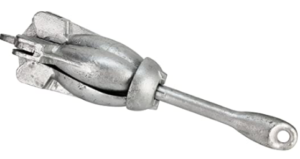
Just like is shown in the image above, you need to make sure your anchor’s flukes are collapsable/foldable. This will take an otherwise large and somewhat difficultly shaped kayak anchor and will allow it to be reduced in size so that it can be efficiently stowed away. If your flukes do not fold, you will be stuck looking for a place to put the irregularly shaped anchor. Also, the collapsable/foldable flukes make it far easier to deploy the anchor (i.e.: throw it out into the water).
Length of Rope
This is an important consideration. While most kayak fishermen tend to tie up in the shallows (roughly 20 feet or so), you don’t go wrong by having too long of a rope. We think 50 feet is sufficient to allow your kayak to drift along with the current/waves without getting too far from the area in which you intend to be anchored.
Importantly, you can increase your rope length as long as you’d like, and doing so does have some benefits. The important thing is so allow sufficient give and length so as to allow you kayak to drift to a certain degree. Flexibility is key!
Attachment
This one seems like a no brainer, right? WRONG! There are correct and incorrect locations to which to attached your kayak anchor. You want to find an islet or cleat near the bow (front) or stern (back) of your kayak, especially given the kayak’s long and narrow dimensions. Doing so will allow your kayak to drift in such a manner so that the waves approach from the front or rear (rather than the sides). This is even more important if you are in an inflatable kayak (and you should look into getting an inflatable kayak stabilizer).
Kayaks, like most boats, are designed to handle waves from the wrong and the back. When encountering waves from the side, the kayak will rock heavily, resulting in unstable and maybe even dangerous conditions for the fishermen. If you can’t find a cleat or islet in the perfect spot, you can buy one on the aftermarket and install it in the ideal location. Just make sure you ensure a flush connection where there is no room for the water to seep through!
Drift Chutes
KFC readers have written in about alternatives to anchors and grabbers. The first is a product known as a Talon by Minn Kota (which we have thoroughly reviewed). The second is known as a drift chute. Here is an example:
These types of products are connected to fishing kayaks (and other vessels, for that matter) and are allowed to drift behind the kayak while, for example, a kayak is being pulled by a swift current or strong wind. While not technically an “anchor”, it does accomplish a similar result in that it keeps you from drifting away from your intended location too quickly. They are relatively easy to use, however, if you are looking for something that is going to keep you centered around one fixed location, an anchor or a grabber is your better bet!
The 5 Best Kayak Anchors: Conclusion
We hope this post has served as a useful guide for teaching you everything there is to know about kayak anchors (and similar anchoring products). Kayak anchors are truly a “must have” in every fishing kayak. That is why we felt the need to list the 5 best kayak anchors!
While there are pros and cons to each of the different styles, that is actually a blessing in disguise! As mentioned above, each kayak fisherman is different from the next, and where one particular person may view a feature as a negative, his partner may view it as a positive! This is why doing your homework before making a purchase decision is so important!
Comments
KFC wants to hear from you! What do you think about our guide on the 5 best kayak anchors? Do you have any particular experience with one of the showcased models? What about a different kind of anchor that you’d like to share your opinion on? We love hearing from our readers and we read and reply to every comment! Thanks for sharing with this kayak fishing community!
